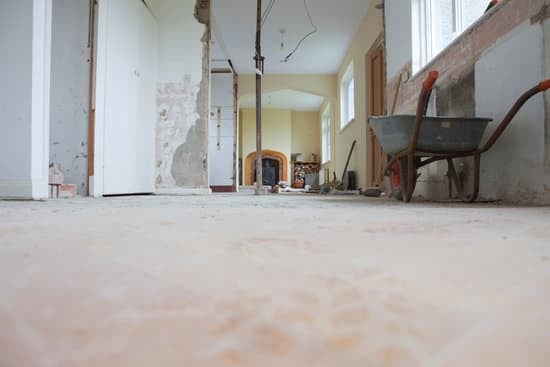Home improvements are a significant investment that homeowners undertake to maintain and increase the value of their properties. Whether it’s updating a kitchen or adding a new bathroom, these upgrades can transform your living space and enhance your overall quality of life. However, before diving into any projects, it is crucial to evaluate your home improvement needs and determine the best way to pay for them.
When it comes to home improvements, there is a wide range of projects that homeowners typically consider. From minor renovations like repainting walls or replacing fixtures to major overhauls like remodeling kitchens or adding additional rooms, each project serves a unique purpose in enhancing the functionality and aesthetics of your home.
Assessing your home improvement needs before deciding on a payment method is essential. It allows you to prioritize projects based on factors such as budget, timeline, and overall goals. Identifying which areas of your home require immediate attention will help you make informed decisions about where to allocate your funds and resources.
By taking the time to evaluate your needs, you can then explore different payment options available for home improvements. Personal savings, home equity loans, credit cards, and contractor financing are some common methods homeowners use to fund their renovation projects. Each option has its own set of pros and cons in terms of interest rates, repayment terms, fees, and associated risks.
In this article, we will delve deeper into these payment options and discuss the benefits and considerations associated with each one. By understanding the various ways you can finance your home improvements, you will be able to make an informed decision that aligns with your financial circumstances and goals. So let’s explore the best way to pay for home improvements and embark on transforming your humble abode into the perfect space you’ve always envisioned.
Assess your Home Improvement Needs
Before deciding on a payment method for home improvements, it is crucial to assess your home improvement needs. Taking the time to evaluate your needs will help you make informed decisions and prioritize projects effectively. By doing so, you can ensure that you are investing your resources wisely and maximizing the value of your home.
When assessing your home improvement needs, there are several factors to consider. Firstly, consider the functionality and condition of different areas in your home. Are there any areas that require immediate attention due to safety concerns or structural issues? Additionally, think about which projects can provide the most significant return on investment. For example, kitchen renovations and bathroom upgrades tend to have high resale values.
Furthermore, take into account your lifestyle and personal preferences. Some people may prioritize aesthetic upgrades or energy-efficient improvements while others may focus on increasing living space or creating a more functional layout. By considering these factors, you can determine which projects align with your goals and allocate your resources accordingly.
Once you have identified your home improvement needs, it is essential to establish a budget for each project. This will help guide you in choosing an appropriate payment method that aligns with your financial capabilities. Planning and budgeting will also enable you to set realistic expectations and avoid overspending.
By taking the time to assess your home improvement needs before making any financial decisions, you can ensure that you are investing in projects that will enhance both the functionality and value of your home.
Evaluating Different Payment Options
When it comes to financing your home improvements, it is essential to carefully evaluate the different payment options available. Each option has its own set of advantages and considerations, so it’s important to choose the method that best suits your financial situation and goals. Let’s take a closer look at the key payment options for home improvements and compare their pros and cons.
1. Personal Savings:
Using personal savings is often considered the most cost-effective way to pay for home improvements. It allows you to avoid paying interest or fees associated with other financing methods. Additionally, using personal savings gives you more control over your finances and reduces the risk of taking on debt.
However, one drawback is that tapping into your savings account may deplete emergency funds or hinder other investment opportunities. To save effectively for home improvements, create a budget specifically for this purpose, automate your savings contributions, and explore ways to cut expenses and increase income.
2. Home Equity Loans:
A popular option for larger-scale home improvements is borrowing against the equity in your property through a home equity loan. These loans typically offer lower interest rates compared to credit cards or personal loans due to being secured by your home’s value.
Additionally, the interest on home equity loans may be tax-deductible, making it an attractive option for some homeowners. However, it’s vital to consider the risks associated with using your home as collateral, as defaulting on payments could lead to foreclosure.
3. Credit Cards:
Credit cards can provide a convenient way to finance smaller home improvement projects. They offer flexibility in terms of repayment options and reward programs that may benefit frequent users. However, high-interest rates associated with credit cards make them less ideal for long-term or large-scale projects. There is also a risk of overspending if not used responsibly.
4. Contractor Financing:
Contractor financing is often offered by contractors themselves or through partnerships with financial institutions specifically for funding home improvement projects. It can provide streamlined application processes and promotional offers, such as low or zero interest rates for a limited time. However, it’s important to carefully review the terms and conditions of contractor financing, as it may come with higher interest rates in the long run compared to other options.
Ultimately, the best way to pay for home improvements depends on your financial situation and goals. Consider factors such as your current savings, credit score, interest rates, repayment terms, and desired timeline for completing the projects.
It may be beneficial to consult with a financial advisor or loan officer who can provide guidance based on your specific circumstances. By evaluating different payment options thoroughly, you can make an informed decision that will help you achieve your home improvement goals while maintaining financial stability.
Personal Savings
When it comes to paying for home improvements, using personal savings can be a smart and practical option. By tapping into your own funds, you can avoid interest charges and maintain control over your finances. However, it’s important to consider the benefits and potential drawbacks of using personal savings before making a decision.
One of the major advantages of using personal savings is the cost-saving aspect. By using your own money, you won’t have to worry about paying interest on loans or credit card balances. This can save you a significant amount of money in the long run. Additionally, using personal savings allows you to avoid taking on additional debt, which can provide peace of mind and financial security.
Despite these benefits, there are some considerations to keep in mind when using personal savings for home improvements. One potential drawback is depleting your emergency fund or other savings accounts. It’s crucial to ensure that you still have enough funds set aside for unexpected expenses or future investments. Prioritize your needs and weigh the importance of each home improvement project against your overall financial goals.
Here are some tips on how to save effectively for home improvements:
- Set a specific budget: Determine how much you need for each project and create a savings goal.
- Automate your savings: Set up a direct deposit so that a portion of your paycheck goes directly into your home improvement fund.
- Cut unnecessary expenses: Evaluate your monthly spending habits and identify areas where you can cut back in order to contribute more to your savings.
- Seek out discounts or deals: Shop around for the best prices on materials or services needed for your home improvements.
- Consider alternative income sources: Explore ways to increase your income through part-time jobs or freelance work specifically aimed at funding your home improvement projects.
By carefully considering the benefits and potential drawbacks of using personal savings, as well as implementing effective saving strategies, you can successfully finance your home improvement projects while maintaining financial security. It’s important to assess your own financial situation and goals in order to make the best decision for your unique circumstances.
Home Equity Loans
Home equity loans can be a valuable option for homeowners looking to finance their home improvements. These loans allow you to tap into the equity you have built up in your property and use it as collateral for a loan. By understanding how home equity loans work and weighing the benefits and risks, you can determine if this payment option is right for you.
One of the major advantages of using a home equity loan to pay for your home improvements is potentially lower interest rates compared to other financing options. This is because the loan is secured by your property, which reduces the risk for lenders. Additionally, the interest you pay on a home equity loan may be tax-deductible, depending on your individual circumstances. This can lead to further savings.
However, it is important to consider the risks associated with using your home as collateral for a loan. If you default on your loan payments, you could potentially lose your property through foreclosure. It is crucial to carefully consider your ability to make regular payments before taking out a home equity loan.
Before deciding on a home equity loan as your payment method, you should also evaluate your future plans and financial goals. If you plan on selling your home in the near future, taking out a large loan could significantly reduce the equity you have in your property when it comes time to sell. Be sure to weigh these factors against the potential benefits of using a home equity loan for financing your home improvements.
In summary, utilizing a home equity loan can be an effective way to pay for home improvements if used responsibly and after careful consideration of both the advantages and risks involved. By understanding how these loans work and considering how they align with your financial goals, you can make an informed decision regarding whether or not they are the best payment option for you.
Credit Cards
Using Credit Cards for Home Improvement Payments
Credit cards can be a convenient and accessible way to pay for home improvements. With their widespread acceptance, credit cards offer the flexibility to make payments at various merchants, including home improvement stores and contractors. However, it is important to carefully consider the advantages and potential drawbacks associated with using credit cards for these expenses.
Advantages of Using Credit Cards
One advantage of using credit cards for home improvement payments is the convenience they provide. With a credit card in hand, homeowners can easily purchase necessary materials or hire contractors without the need for cash or checks. Furthermore, some credit card companies offer reward programs that allow users to earn points or cash back on their purchases, which can be beneficial if homeowners plan on making significant purchases for their home improvements.
Another benefit of using credit cards is the potential short-term financing they offer. By paying off the balance within the billing cycle, homeowners can avoid interest charges altogether. This can be particularly useful for smaller home improvement projects that can be paid off quickly.
Potential Disadvantages of Using Credit Cards
While credit cards provide convenience and potential rewards, it is essential to consider their high-interest rates. If homeowners cannot pay off the balance in full within the billing cycle, interest charges will start accruing on the remaining balance. These high-interest rates can quickly add up and make the total cost of home improvements significantly higher than anticipated.
Additionally, there is a risk of overspending when using credit cards. The availability of credit limits might tempt homeowners into purchasing more expensive materials or taking on additional projects beyond what they initially planned for. This could lead to financial strain and difficulties in managing debt repayment.
To mitigate these risks, responsible budgeting and careful planning are crucial when utilizing credit cards for home improvements. Homeowners should have a clear repayment plan in place before making any charges to their credit cards, ensuring that they can comfortably pay off the balance within a realistic timeframe.
By considering the advantages and disadvantages of using credit cards for home improvement payments, homeowners can make an informed decision on whether this payment method is suitable for their needs and financial situation.
Contractor Financing
Contractor financing is an alternative option for homeowners looking to pay for their home improvements. This method involves working with a contractor who offers financing options to help cover the costs of the project. In this section, we will explore the benefits and considerations of using contractor financing.
One of the main advantages of contractor financing is the simplified application process. Unlike traditional loans or credit cards, contractor financing often has a streamlined approval process, allowing for quick and easy access to funds. This can be especially beneficial for homeowners who need to start their home improvements right away but may not have immediate access to other forms of payment.
Additionally, many contractors offer promotional offers or special financing terms to attract customers. This can include low or zero-interest rates, deferred payments, or extended repayment periods. These options can help homeowners manage their cash flow and make their home improvement projects more affordable.
However, there are also potential drawbacks to consider when using contractor financing. One common concern is that contractors may have limited options in terms of lenders or financial institutions they work with. This means that homeowners may not have as many choices when it comes to interest rates or repayment terms.
Furthermore, it’s important for homeowners to carefully review any contractual agreements before proceeding with contractor financing. Some contractors may include clauses that allow them to place liens on the property if payments are not made on time or in full. Homeowners should ensure they fully understand all terms and conditions before entering into any financial agreement.
Overall, contractor financing can be a viable option for homeowners seeking funding for their home improvement projects. However, it’s essential for individuals to carefully weigh the benefits and considerations and determine if this method aligns with their financial needs and goals.
| Advantages | Considerations |
|---|---|
| – Simplified application process | – Limited options |
| – Promotional offers and special financing terms | – Contractual agreements |
The Best Way to Pay for Home Improvements
The decision of how to pay for home improvements is an important one that requires careful consideration. With various payment options available, it can be challenging to determine the best approach. This section will provide guidance on making the right decision when it comes to paying for home improvements based on personal financial circumstances and goals.
Evaluating Financial Circumstances
Before deciding on a payment method, it is crucial to assess your current financial circumstances. Consider factors such as your income, savings, existing debts, and credit score. This evaluation will help you understand how much you can afford to allocate towards home improvements and which payment options are realistic for you. It’s also important to consider your future financial obligations, such as upcoming expenses or investment opportunities.
Determining Goals and Priorities
Understanding your goals and priorities is key in deciding the best way to pay for home improvements. Ask yourself questions like: Are you planning on staying in your home long-term? Do you want to increase its value for potential resale? Are there specific areas of improvement that are more urgent than others? By determining your goals and priorities, you can align them with the most suitable payment method.
Considering Long-Term Impact
When choosing a payment method for home improvements, it’s essential to consider the long-term impact on your finances. Evaluate factors such as interest rates, repayment terms, and fees associated with each option.
For example, while personal savings may have no interest or fees attached, using credit cards could result in high-interest rates if not paid off promptly. Home equity loans offer potentially lower interest rates but should be evaluated carefully due to the risk of using your property as collateral.
By evaluating your financial circumstances, determining goals and priorities, and considering the long-term impact of different payment methods, you can make an informed decision on how to fund your home improvements effectively. It is recommended that you create a budget and plan for the project, taking into account not only the cost of materials and labor but also the potential impact on your monthly finances.
With careful consideration and planning, you can embark on your home improvement journey and transform your home with the right financial approach.
Conclusion
In conclusion, when it comes to financing your home improvements, it is crucial to approach the decision with careful consideration and analysis. As discussed throughout this article, there are several payment options available, each with its own set of pros and cons. Ultimately, the best way to pay for your home improvements will depend on your personal financial circumstances and goals.
Personal savings can be a great option for those who have sufficient funds set aside specifically for home improvements. It offers flexibility and eliminates the need to take on debt or pay interest. However, it is important to weigh the potential drawbacks, such as depleting emergency funds or missing out on investment opportunities. Effective saving strategies, such as creating a dedicated account or automating savings contributions, can help ensure that you are financially prepared for your home improvement projects.
Another option to consider is tapping into your home equity through a home equity loan. This type of loan can offer lower interest rates compared to other financing options and may provide potential tax benefits. However, it also involves using your property as collateral, which means there is a risk of foreclosure if you default on the loan.
Credit cards may provide convenience and reward programs, but they often come with high-interest rates that can quickly accumulate if not paid off in full within the grace period. If considering this option, it is essential to have a solid plan for timely repayment.
Contractor financing is an alternative to consider if traditional loan options do not meet your needs. While it may offer simplified application processes and promotional offers at times, limited options and potentially higher interest rates should also be taken into account.
In making your decision about how best to pay for home improvements, it is important to thoroughly evaluate all available options and consider your long-term financial goals. Set a realistic budget for your project and create a comprehensive plan that allows you to successfully manage payment obligations. By taking these steps now, you can transform your home while staying financially secure in the process. So, take action today and begin your home improvement journey with the right financial approach.
Frequently Asked Questions
How can I save $$ on a house remodel?
There are several ways to save money on a house remodel. Firstly, it’s important to plan and budget before starting any project. This will help you prioritize what needs to be done and avoid unnecessary expenses. Consider doing some of the work yourself if you have the skills and time, as hiring professionals can be costly.
Another way to save is by shopping around for materials and appliances, comparing prices from different suppliers or looking for sales and discounts. Additionally, consider reusing or repurposing some items instead of buying new ones. Finally, try to avoid making changes to the original layout or structure of the house, as this can add significant expenses.
How do you finance improvements?
There are various ways to finance home improvements depending on your financial situation and preferences. One common option is taking out a home equity loan or line of credit, using the equity built in your property as collateral. These loans typically offer competitive interest rates but require careful planning as defaulting could result in losing your home.
Another option is refinancing your mortgage, combining your existing loan with additional funds for improvements. This may be beneficial if current interest rates are lower than what you initially secured. Additionally, personal loans or credit cards can also be used for smaller projects but may come with higher interest rates.
Are renovation loans a good idea?
Whether renovation loans are a good idea depends on several factors including your overall financial situation and goals for the property. Renovation loans can offer advantages such as allowing you to finance both the purchase price and renovation costs into one loan package, simplifying the process of financing improvements on a fixer-upper property or partially financing major upgrades on an existing home.
However, they often come with stricter requirements and higher interest rates compared to traditional mortgages due to the increased risk associated with renovation projects. It’s important to carefully evaluate whether the potential benefits outweigh these drawbacks before deciding if a renovation loan is right for you.

I’m thrilled to have you here as a part of the Remodeling Top community. This is where my journey as an architect and remodeling enthusiast intersects with your passion for transforming houses into dream homes.





